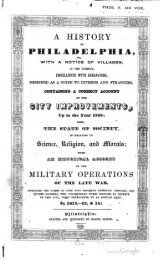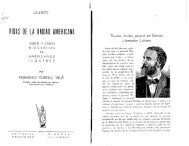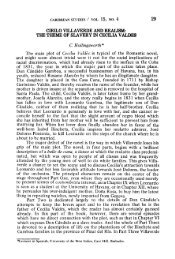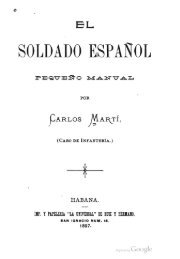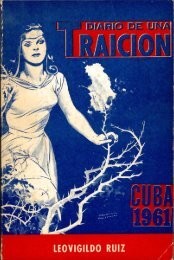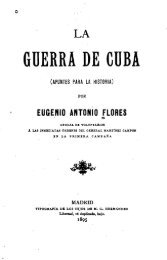Areas and Periods of Culture in the Greater Antilles
Areas and Periods of Culture in the Greater Antilles
Areas and Periods of Culture in the Greater Antilles
Create successful ePaper yourself
Turn your PDF publications into a flip-book with our unique Google optimized e-Paper software.
258<br />
SOUTHWESTERN<br />
JOURNAL OF ANTHROPOLOGY<br />
warriors wore on <strong>the</strong>ir foreheads to ensure victory <strong>in</strong> battle.46 It is <strong>the</strong>refore<br />
assumed that <strong>the</strong> worship <strong>of</strong> zemis had begun to develop dur<strong>in</strong>g Period IIIb.<br />
<strong>Periods</strong> IVa <strong>and</strong> IVb. Five new styles are known to have made <strong>the</strong>ir appearance<br />
dur<strong>in</strong>g <strong>Periods</strong> IVa <strong>and</strong> IVb: Esperanza, Capa, Boca Chica, Carrier, <strong>and</strong><br />
Pueblo Viejo (Fig. 2). The most elaborate <strong>of</strong> <strong>the</strong>se is <strong>the</strong> Boca Chica, <strong>in</strong> <strong>the</strong><br />
Dom<strong>in</strong>ican Republic.47 Both bottles <strong>and</strong> bowls are <strong>in</strong>cluded <strong>in</strong> this style, <strong>and</strong> <strong>the</strong><br />
latter are commonly provided with an <strong>in</strong>turned shoulder, decorated with elaborate<br />
curvil<strong>in</strong>ear <strong>in</strong>cised designs. The outturned shoulder, which had been characteristic<br />
<strong>of</strong> <strong>the</strong> previous Cuevas <strong>and</strong> Ostiones styles, is now rare, as are also pa<strong>in</strong>t<strong>in</strong>g <strong>and</strong><br />
loop h<strong>and</strong>les. On <strong>the</strong> o<strong>the</strong>r h<strong>and</strong>, large modeled <strong>in</strong>cised anthropomorphic head<br />
lugs become common, <strong>and</strong> similar designs are modeled on vessel walls.<br />
S<strong>in</strong>ce <strong>the</strong> o<strong>the</strong>r new styles <strong>of</strong> this time are variations on <strong>the</strong> Boca Chica, <strong>the</strong>y<br />
will not be described, except to say that <strong>the</strong>y exhibit an <strong>in</strong>creas<strong>in</strong>g simplicity as<br />
one moves east <strong>and</strong> west from <strong>the</strong> home <strong>of</strong> <strong>the</strong> Boca Chica style <strong>in</strong> <strong>the</strong> Dom<strong>in</strong>ican<br />
Republic, as if <strong>the</strong>y were derived from <strong>the</strong>re. It is probable, <strong>in</strong>deed, that Pueblo<br />
Viejo, <strong>the</strong> Cuban style, is <strong>the</strong> result <strong>of</strong> a late migration from Haiti, which is<br />
mentioned <strong>in</strong> <strong>the</strong> sources.48 The development <strong>of</strong> <strong>the</strong> two Puerto Rico variants-<br />
Capai <strong>and</strong> Esperanza-may have been touched <strong>of</strong>f by a similar migration from <strong>the</strong><br />
Dom<strong>in</strong>ican Republic, for we have found several <strong>in</strong>trusive Boca Chica sites <strong>in</strong> a<br />
part <strong>of</strong> Puerto Rico where <strong>the</strong> development is likely to have taken place.49<br />
It is with <strong>the</strong> new ceramic styles <strong>of</strong> <strong>Periods</strong> IVa <strong>and</strong> IVb that most <strong>of</strong> <strong>the</strong><br />
datable ball courts <strong>and</strong> o<strong>the</strong>r ceremonial structures <strong>and</strong> artifacts <strong>of</strong> <strong>the</strong> <strong>Antilles</strong><br />
are associated. They appear <strong>in</strong> greatest variety <strong>in</strong> <strong>the</strong> Dom<strong>in</strong>ican Republic <strong>and</strong><br />
western Puerto Rico, where <strong>the</strong>y <strong>in</strong>clude ball courts, dance grounds, <strong>and</strong> s<strong>in</strong>gle<br />
stone columns, <strong>of</strong>ten marked with petroglyphs; carv<strong>in</strong>gs <strong>of</strong> zemis <strong>in</strong> stone, bone,<br />
<strong>and</strong> shell; swallow sticks, used to <strong>in</strong>duce vomit<strong>in</strong>g; carved stools (<strong>the</strong>se were a<br />
sign <strong>of</strong> rank <strong>in</strong> historic times); <strong>and</strong> such problematical artifacts as stone collars,<br />
elbow stones, <strong>and</strong> three-po<strong>in</strong>ted stones.50 The carv<strong>in</strong>gs are similar to <strong>the</strong> modeled<br />
head lugs <strong>of</strong> <strong>the</strong> various ceramic styles, <strong>and</strong> it is probable that both represent<br />
zemis; <strong>in</strong> fact, <strong>the</strong> historic sources <strong>in</strong>dicate that <strong>the</strong> Arawak <strong>of</strong> Hispaniola portrayed<br />
zemis on <strong>the</strong>ir household utensils as well as on ceremonial objects.51<br />
As <strong>in</strong> <strong>the</strong> case <strong>of</strong> <strong>the</strong> pottery, <strong>the</strong> ceremonial complex appears simpler <strong>the</strong><br />
far<strong>the</strong>r one moves east <strong>and</strong> west from its center <strong>in</strong> western Puerto Rico <strong>and</strong> <strong>the</strong><br />
46 Rouse, 1941, fig. 7; Loven, 1935, p. 580.<br />
47 Herrera Fritot <strong>and</strong> Youmans, 1946; Krieger, 1931.<br />
48 Las Casas, 1875, vol. 3, p. 474.<br />
49 Rouse, MSa.<br />
50 Fewkes, 1907, pp. 53-58.<br />
51 Rouse, 1939, pp. 58-59.




